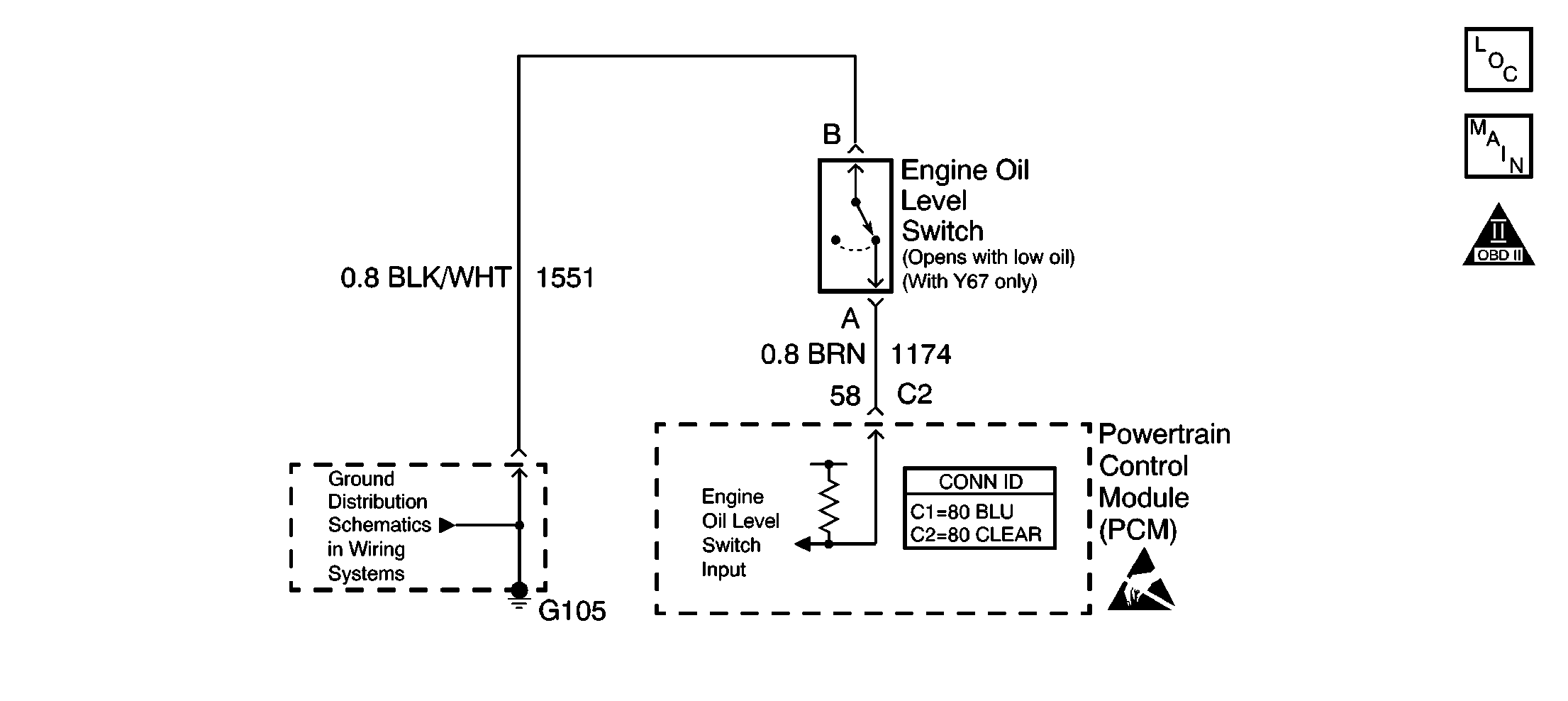
Circuit Description
The engine oil level switch is a simple float switch that is grounded when the engine oil level is OK. The PCM checks the engine oil level switch circuit at startup. Before checking the state of the engine oil level switch, the PCM performs a test routine based on time and engine coolant temperature to ensure that the engine oil has drained back into the sump. To test for low oil level at startup, one of the following conditions must be present:
| • | If the engine coolant temperature was between 15°C (59°F) and 130°C (266°F) at the last key OFF, the engine coolant temperature at key ON must be at least 12°C (22°F) cooler than the engine coolant temperature at the last key OFF. |
| • | If the engine coolant temperature was higher than 82°C (150°F) at the last key OFF, the time between last key OFF and the present key ON must be sufficient to allow the oil to drain back to the sump. The PCM will remain powered up for 10 seconds to ensure that the oil has drained back to the sump. If the key is turned back ON while the PCM is still powered up, the oil level will not be tested. |
The Low Oil Level lamp will be illuminated for approximately 7 minutes when the PCM checks for low oil level and the engine oil level switch indicates that a low oil level condition exists ). When the ignition is first turned ON, the PCM commands the Low Oil Level lamp ON for a brief period of time to test the bulb.
Diagnostic Aids
For diagnosis of the instrument panel, perform the Diagnostic System Check - Instrument Cluster in Instrument Panel, Gauges, and Console.
Check for the following conditions:
| • | A poor connection at the PCM or the oil level sensor. |
| Inspect the harness connectors for backed out terminals, improper mating, broken locks, improperly formed or damaged terminals, and poor terminal to wire connection. Use a corresponding mating terminal to test for proper terminal tension. |
| • | A damaged harness. |
| Inspect the wiring harness for damage. If the harness appears to be OK, disconnect the PCM and turn the ignition ON. Observe a voltmeter connected to the affected PCM output circuit while moving the connectors and the wiring harnesses related to the PCM output circuit. A change in voltage will indicate the location of the fault. |
Test Description
The number below refers to the step number on the diagnostic table:
Step | Action | Value(s) | Yes | No |
|---|---|---|---|---|
1 | Did you perform the Powertrain On-Board Diagnostic (OBD) System Check? | -- | ||
2 |
Important: This table assumes that the oil level is at the proper level or the oil level was low and the Low Oil Level message never was displayed. Check for body control module (BCM) DTCs. With a scan tool, observe the Oil Level parameter. Does the scan tool indicate OK? | -- | ||
3 |
Does the scan tool indicate LOW when the switch is disconnected? | -- | Go to Diagnostic Aids | |
4 |
Does the scan tool indicate OK when the jumper is installed? | -- | ||
5 |
Does the scan tool indicate OK when the jumper is installed? | |||
6 | Probe the signal circuit using a test lamp connected to ground. Does the test lamp illuminate? | -- | ||
7 | Test for a short to ground on the signal circuit. Refer to Circuit Testing and Wiring Repairs in Wiring Systems. Did you find and correct the condition? | -- | System OK | |
8 | Test for a short to voltage on the signal circuit. Refer to Circuit Testing and Wiring Repairs in Wiring Systems. Did you find and correct the condition? | -- | System OK | |
9 | Repair the open in the ground circuit. Refer to Wiring Repairs in Wiring Systems. Did you complete the repair? | -- | System OK | -- |
10 | Test for an open in the signal circuit. Refer to Circuit Testing and Wiring Repairs in Wiring Systems. Did you find and correct the condition? | -- | System OK | |
11 | Inspect for poor connections at the switch. Refer to Testing for Intermittent Conditions and Poor Connections and Connector Repairs in Wiring Systems. Did you find and correct the condition? | -- | System OK | |
12 | Replace the oil level switch. Did you complete the repair? | -- | System OK | -- |
13 |
Did you find and correct the condition? | -- | System OK | |
|
Important: The replacement PCM must be programmed. Replace the PCM. Refer to Powertrain Control Module Replacement/Programming . Did you complete the repair? | -- | System OK | -- |
